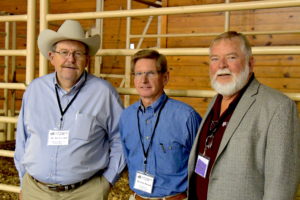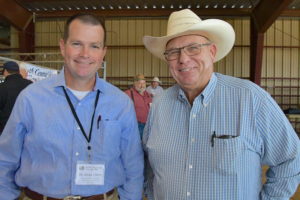Cattle tick, handling demonstrations featured at 47th South Texas Cow-Calf Clinic
Writer: Blair Fannin, 979-845-2259, [email protected]
BRENHAM – Ranchers working cattle this fall and winter, or surveying pastures and wildlife, need to be mindful of ticks harboring on livestock and forage habitats.
Dr. Pete Teel, Texas A&M AgriLife Research entomologist in College Station, recently gave a tick update at the 47th South Texas Cow-Calf Clinic in Brenham.

Teel discussed a variety of ticks common to Texas, including those that have not entered the Lone Star state and pose potential health consequences not just for cattle, but for humans.
One of the most common ticks in Texas is the Lone Star tick. It is a three-host tick, starting out as a tiny seed tick on animals, then dropping back into the environment to molt to nymphs. Nymphs repeat this sequence attaching and feeding on a second host, dropping into the environment to molt to adult ticks, then attach and feed on the third host, Teel said.
Cattle and wildlife such as deer or feral hogs are common hosts for this tick.
“More than 95 percent of this tick’s life is spent in the pasture in vegetation types that support tick development and access to hosts,” Teel said.
Another tick found in Texas, the Gulf Coast tick, is also a three-host tick.
“They particularly like to infest ground dwelling birds during the larval and nymphal stages, and infested birds can be a continuous source of pasture infestation,” he said. “Adult Gulf Coast ticks like to attach themselves to the ears of livestock or wildlife.
“Pesticide-impregnated ear tags were originally developed to control infestations of Gulf Coast ticks on cattle, and this control tactic remains effective if applied during the peak infestation period from July to October in Texas.”
Teel stressed practicing good biosecurity. He advised cattle producers purchasing cattle to temporarily quarantine new animals to inspect, treat and observe them prior introducing them to the home herd.

“Newly purchased animals of any species could serve as potential hosts for ticks,” Teel said.
The potential for the Asian Longhorn tick to enter Texas looms. It was discovered in nine states in 2018, including Arkansas, he said. The climate of Texas is predicted to support the Asian Longhorn tick, so surveillance in 2019 will be needed, he noted.
“It was discovered on a sheep farm in the summer of 2017 in New Jersey, and experts think it may have been introduced to the U.S. as early as 2010,” Teel said. “Originating from China, it long ago spread to Australia and New Zealand. It is a relatively small, brownish tick, but can do a lot of damage.”
Teel said the Longhorn tick is a “highly adaptable tick” and is likely to spread over much of the U.S.
Teel reviewed the history and ecology of cattle fever ticks and provided an update on cattle fever tick infestations. He reminded the audience of the risks of cattle fever ticks and their transmission of pathogens causing bovine babesiosis.
“At risk is our economy of the Texas cattle industry and the more than 400,000 cattle producers throughout the southern region where this tick could survive if permitted to be reintroduced,” Teel said.
“More than one third of the U.S. fed cattle are produced in this region. U.S. cattle are naive to b ovine b abesiosis and mortality is estimated to exceed 70 percent in naïve cattle. There are no protective vaccines or approved drugs. Our focus is to prevent the only vector, cattle fever ticks, from re-establishing populations in the U.S.”
For more information, Teel said producers can visit http://tickapp.tamu.edu/ for a complete background on common ticks found in Texas and more in the mobile app available for smartphones.
Also during the program, Dr. Joe Paschal, AgriLife Extension livestock specialist in Corpus Christi, discussed animal identification.

Paschal said it’s important for ranchers to maintain good health records on their herds and have cattle permanently identified with brands and other unique forms of identification. This information is important for source-verified programs, animal disease traceback and required for animal health tests such as brucellosis, he said.
“There’s a need for traceback in the industry resulting from animal diseases,” Paschal said. “There are a lot of diseases out there that affect both humans and animals.
“In the past, the required vaccination of all beef breeding heifers for brucellosis kept the beef cow herd in the U.S. and Texas with a form of permanent identification. However, since all of the U.S. is now free of brucellosis, many cattle producers are no longer brucellosis vaccinating their replacement heifers since it’s no longer required by law.”
Consequently, Paschal said most of the nation’s and state’s cowherd is at risk for lack of any traceability for infection.
“It doesn’t have to be an exotic disease, it could be something as simple as the current c attle f ever t ick outbreak that has required trace backs to 82 different counties in Texas and a number of states.”
Participants also heard an update on Texas Beef Council activities from Mike McCravey, industry relations manager in Austin, and an afternoon session devoted to cattle-handling demonstrations from Dr. Ron Gill, AgriLife Extension livestock specialist and associate department head for animal science at Texas A&M University in College Station.


